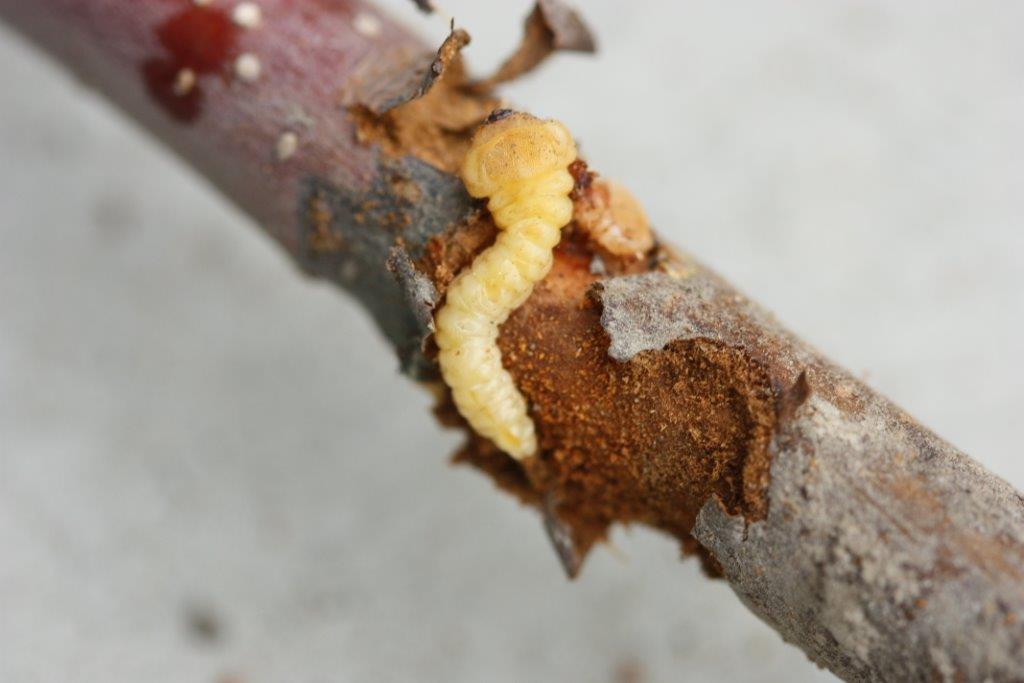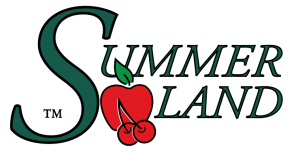Flatheaded borers
General Description
The Pacific flatheaded borer and the flatheaded apple tree borer are native to North America and are known to be present in British Columbia. Flatheaded borer infestation was reported by a grower in 1-2 year old apple trees in Kelowna in July, 2015. Previous reports of flatheaded borer damage to young apple trees were in the Kelowna area in 2003 and Grand Forks in 1921. Larvae collected from the infested site in Kelowna in 2015 were identified by DNA barcoding as Pacific flatheaded borer by Dr. Robert Foottit, Agriculture and Agri-Food Canada, Ottawa, Ontario. Preliminary surveys conducted in 2015 indicate pacific flatheaded borer is present at low levels in orchards in the Okanagan and Similkameen valleys.
Hosts
Hosts include pome and stone fruits, elm, maple, willow, mountain ash, oak, poplar and other trees and shrubs.
Damage
Weak, young, injured, drought-stressed and newly transplanted trees are very susceptible to attack. Injured spots on the bark are coloured, cracked, with sawdust showing through and there may be sawdust around the base of some infested trees (Figs. 1 & 2).
.jpg)
|
.jpg) |
| Figure 1. Infested young apple tree with dark, cracked bark below graft union. (BCMA) | Figure 2. Infested young apple tree with sawdust at the base. (BCMA) |
Damage in young trees is usually below the graft union. Larvae feed on the woody tissue under the bark creating winding tunnels and girdling the young trees (Fig. 3).
.jpg) |
| Figure 3. Girdling damage by flatheaded borer. (BCTFC) |
Larvae can be found beneath the bark or deep inside the wood (Fig. 4).
.jpg) |
| Figure 4. Flatheaded borer larva inside wood. (BCMA) |
Infested trees show variable leaf symptoms from yellowed (early season) to discoloured later in the season (Fig. 5 ).
.jpg) |
| Figure 5. Infested tree showing later season leaf symptoms. (BCMA) |
Identification
Adults
Pacific flatheaded borer adult - flattened wedge-shaped dark brown body, about 6-13 mm (1/4 - 1/2 inch) long, with grey markings on the back (hard wing covers) (Fig. 6).
.jpg) |
| Figure 6. Adult Pacific flatheaded borer. (Utah State University Extension IPM Program) |
Flatheaded apple tree borer - flattened wedge-shaped greenish bronze body, about 6-13 mm (1/4 - 1/2 inch) long, with zigzag markings on the back (Fig. 7).
.jpg) |
| Figure 7. Adult flatheaded apple tree borer. (Joseph Berger, Bugwood.org) |
Larvae
Larvae of both species are cream-coloured, about 2-3 cm (3/4 -1 1/4 inches) long; the segment behind the head is broad and flattened (Fig. 8).
 |
| Figure 8. Pacific flatheaded borer larva. (BCMA) |
Life History
The life cycle of the pacific flatheaded borer in B.C. is not known but information from Washington State indicates adults emerge soon after apple bloom and the female lay eggs on sunny sides of tree trunks from June through July. Eggs hatch from mid-June to mid-August. Larvae bore into bark and feed between the bark and sapwood until fully grown. Mature larvae tunnel into the heartwood to overwinter. Larvae pupate in the spring, and adults emerge after 3-5 weeks. Emergence holes are oval and about ¼ inch in diameter (Fig. 9). There is one generation per year.
.jpg) |
| Figure 9. Pacific flatheaded borer adult exit hole. (Utah State University Extension IPM Program) |
Monitoring
Inspect susceptible trees for symptoms. Look for hard-packed sawdust under flaking bark, usually on the sunny side of trees, larvae beneath the bark, and oval or D-shaped emergence holes on trees. Damage in young trees is usually below the graft union.
Management
Biological Control
Woodpeckers and ants feed on larvae. Parasitic wasps also attack the borer.
Cultural Control
Stressed, injured, sunburned, and newly transplanted trees are susceptible to attack. Remove and destroy infested trees which will not survive attack. Keep trees healthy and provide adequate irrigation during periods of drought and high temperatures. Paint the trunks with a mixture of latex paint and water to prevent sunburn (southwest injury).
Chemical Control
No products are currently registered for control of flatheaded borers in fruit trees in Canada. Larvae are difficult to control after they have entered the bark. An insecticide has to be applied the trees before newly hatched larvae enter the bark. Admire/Alias (imidacloprid) applied against other insect pests will provide control of flatheaded borer larvae.
